The 16-Cell
The 16-cell is the 4D equivalent of the octahedron. Just as the octahedron is bounded by 8 triangles, the 16-cell is bounded by 16 tetrahedra. These tetrahedra meet at 32 triangles, 24 edges, and 8 vertices. The 16-cell is the dual of the tesseract: it is equivalent to the tesseract with vertices and cells exchanged.
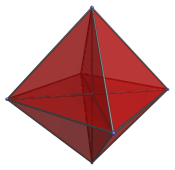
Construction
The 16 tetrahedra of the 16-cell are joined 4 to an edge, just as the octahedron's 8 triangles are joined 4 to a vertex. This way of thinking about the 16-cell, however, can be difficult to visualize. It is relatively easy to understand how 4 tetrahedra sharing a common edge can be “bent” into 4D so that they each share a face with two other tetrahedra. But it is not quite so simple to imagine how 4 sets of tetrahedra attached thus can be assembled into a 16-cell.
Another method of constructing the 16-cell, which may be a bit easier to understand, is to begin with a 3D octahedron and tapering it in both the positive and negative directions along the W-axis. Consider the first case. The process of tapering is simply to stack progressively smaller octahedra on top of each other along the W-axis, until they have vanished to a single point. The tapered object is the trace formed by this process. As we taper the octahedron along the positive W-axis, each of its 8 triangular faces also grow smaller, stacking on top of the larger triangles behind it. At the end of the taper, the triangles vanish into a common apex. Thus, the tapering process forms 8 tetrahedral cells bent into the positive W-axis. This forms half of the 16-cell, with the apex being the +W vertex of the 16-cell. Now we repeat the same process in the negative W-axis, and we get another 8 tetrahedral cells in exactly the same formation, except that they are now bent in the negative W-axis, and form another apex on the opposite point, which is the -W vertex of the 16-cell. Joining these two halves together at their octahedral base, we obtain the entire 16-cell. The remaining 6 vertices of the 16-cell are precisely the 6 vertices of the octahedron we started out with.
With this understanding of the 16-cell, it is easy to see why it is the 4D equivalent of the octahedron. Just as the 2D square diamond is a 1D line segment tapered in the positive and negative Y-axis, and the octahedron is the 2D square diamond tapered in the positive and negative Z-axis, the 16-cell is the octahedron tapered in the positive and negative W-axis.
Vertex-first Projection
The vertex-first projection of the 16-cell is perhaps easiest to understand. It has an octahedral envelope, with the closest vertex lying at the center of the octahedron, and 8 tetrahedral cells surrounding it. The other 8 cells lie “behind” these 8 cells in the W direction, and meet at the opposite vertex.

The following images show how these 8 tetrahedral cells are laid out in the projection image:
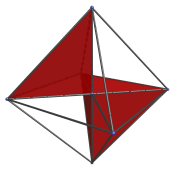
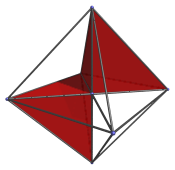
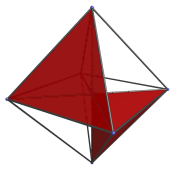
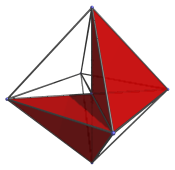
Cell-first Projections
The cell-first parallel projection of the 16-cell has a cubical envelope. This projection is interesting in that all the edges of the 16-cell project onto the edges of the cube and the diagonals on the faces of the cube, forming a wireframe of the cube with each face crossed. It corresponds with the two possible ways to inscribe a tetrahedron inside a cube such that the edges of the tetrahedron lie on the faces of the cube.
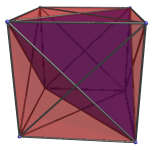
The blue tetrahedron is the closest cell to the 4D viewpoint. Between this cell and the cubical envelope are 4 non-regular tetrahedral volumes that correspond with the 4 cells surrounding this blue cell. The following images show the layout of these 4 cells:
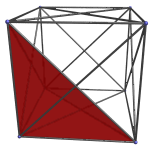
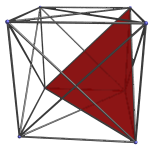
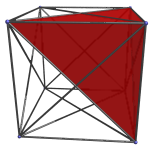
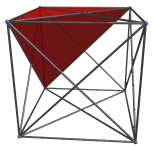
There are 6 cells that project onto the 6 faces of the cubical envelope:
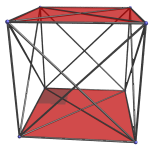
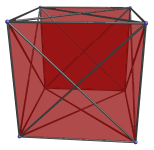
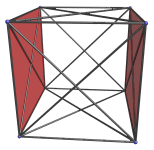
They appear as flat squares because they are seen edge-on. These 6 cells connect with the other side of the 16-cell, which contains the remaining 5 cells in a dual arrangement to the cells seen here, as shown by the following image of the farthest cell on the other side:
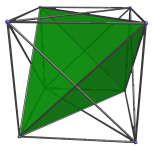
4D is unique in that the cell-first projection of its hypercube is a 3D cube, which is the same envelope as the cell-first projection of its cross polytope. Only 2D has the same phenomenon, although in 2D the hypercube and the cross polytope are in fact the same object (the square).
Face-first projections
The face-first projection of the 16-cell has a hexagonal bipyramid envelope, as shown in the following image:
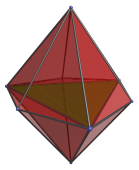
The nearest face is rendered in green, and lies across the center of the bipyramid.
The following images show the layout of cells in this projection:
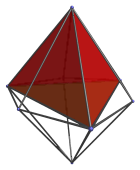
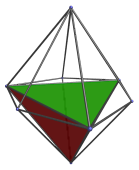
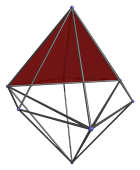
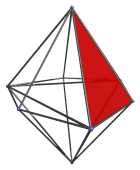
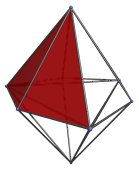
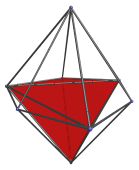
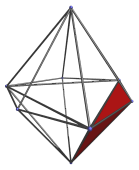
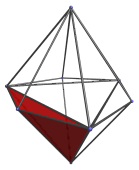
Only eight cells are visible here, as the other eight cells lie on the far side of the 16-cell and are obscured.
Coordinates
The coordinates of the 16-cell with circumradius 1 and edge length √2 are all permutations of:
(±1,0,0,0)
The 16-cell can also be obtained as the alternation of the tesseract. Given a tesseract whose coordinates are all changes of sign of (1,1,1,1), we can derive two 16-cells: the first one with the coordinates that have an even number of negative signs, and the second with coordinates that have an odd number of negative signs. These coordinates correspond with the cell-first projection of the 16-cell, whose projection envelope is a cube.
The radius of the two 16-cells thus derived is 2, so if we scale the 16-cell described by the first set of coordinates such that its radius is 2, its coordinates become all permutations of (±2,0,0,0). All three 16-cells now have radius 2, and if we combine all of them together and take their convex hull, we obtain the 24-cell.




